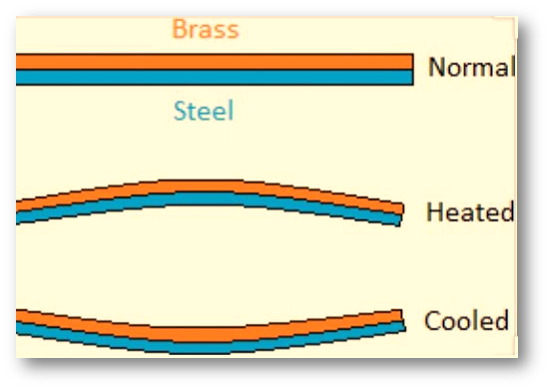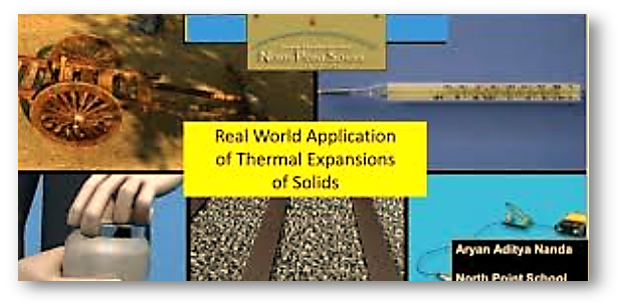EXTREME WEATHERS!!
Iron is a metal that expands when it is heated, and contracts when it is cooled. This phenomenon is known as thermal expansion. Therefore, it is likely that iron would expand during the summer months when temperatures are warmer. However, it is important to note that the amount of expansion will depend on the specific temperature range and conditions to which the iron is exposed. And Thermal contraction is a physical property that is intrinsic to all types of matter, including solids, liquids, and gases.
THERMAL EXPANSION IN SUMMERS!!

Thermal expansion is the tendency of matter to change in volume in response to a change in temperature. When a substance is heated, its molecules begin to move more quickly and move farther apart, causing the substance to expand. Conversely, when a substance is cooled, its molecules slow down and move closer together, causing it to contract. The amount of expansion or contraction that a substance undergoes as a result of a change in temperature is known as its coefficient of thermal expansion. Different substances have different coefficients of thermal expansion, which means they will expand or contract by different amounts when subjected to the same change in temperature.
THERMAL CONTRACTION IN WINTER!!
Thermal contraction is the tendency of a substance to decrease in volume in response to a decrease in temperature. As the temperature of a substance decreases, the kinetic energy of its atoms or molecules decreases, leading to a decrease in the average separation distance between them. As a result, the substance contracts.
Thermal contraction is a physical property that is intrinsic to all types of matter, including solids, liquids, and gases. The amount of contraction that a substance undergoes as a result of a change in temperature is dependent on the substance and is known as its coefficient of thermal contraction. Different substances have different coefficients of thermal contraction, which means they will contract by different amounts when subjected to the same change in temperature.
Thermal contraction can have a number of effects, such as causing damage to buildings and infrastructure, impact on transportation, impact on water systems, impact on energy generation, and impact on natural habitats. It is important to take thermal contraction into account during the construction, design, and maintenance of buildings, infrastructure, and industrial processes.
EFFECTS OF THERMAL EXPANSION IN SUMMERS!!

Thermal expansion can have a number of effects during the summer months. Some examples include:
Damage to buildings and infrastructure:
If the expansion of building materials (such as metal or concrete) is not taken into account during construction, it can cause cracks and other types of damage when temperatures rise.
Impact on transportation:
The expansion of rails on a train track can cause them to warp, which can cause train delays or accidents. Similarly, the expansion of road surfaces can cause buckling or other types of damage.
Impact on water systems:
Thermal expansion can cause water pipes to burst or leak. Which can lead to property damage or loss of water pressure.
Impact on energy generation:
Thermal expansion can cause problems for power plants that rely on the expansion and contraction of fluids to generate electricity.
Impact on beach activities:
The thermal expansion of water causes the sea level to rise. Which can cause flooding on low-lying beaches and coastal areas.
It’s also worth noting that thermal expansion is also a cause of global warming or climate change. As the temperature of the earth increases, the oceans expand, leading to a rise in sea level and increased coastal flooding.
THERMAL cONTRACTION IN WINTER!!

The opposite of thermal expansion is thermal contraction. Thermal contraction occurs when a substance is cooled and its molecules slow down and move closer together. Causing it to decrease in volume.
During the winter months, the contraction of materials can have a number of effects, such as:
Damage to buildings and infrastructure:
If the contraction of building materials is not taken into account during construction. It can cause gaps and other types of damage when temperatures drop.
Impact on transportation:
The contraction of rails on a train track can cause them to warp or pull apart. Which can cause train delays or accidents. Similarly, the contraction of road surfaces can cause cracking or other types of damage.
Impact on water systems:
Thermal contraction can cause water pipes to burst or leak, which can lead to property damage or loss of water pressure.
Impact on energy generation:
Thermal contraction can cause problems for power plants that rely on the expansion and contraction of fluids to generate electricity.
Impact on natural habitats:
Thermal contraction can cause damage to the habitats of certain animals and plants that are adapted to specific temperature ranges.
Impact on agriculture:
Thermal contraction can cause damage to crops that are adapted to specific temperature ranges.
It’s also worth noting that thermal contraction is also a cause of global warming or climate change. As the temperature of the earth decreases, the oceans contract, leading to a fall in sea level and increased coastal erosion.
WINTER, THERMAL CONTRACTION, AND DAILY LIFE ISSUES!!

Thermal contraction in the winter can have a number of effects on daily life, some examples include:
Heating costs:
Colder temperatures mean that people will use more energy to heat their homes and buildings, which can lead to higher heating costs.
Damage to pipes and water systems:
Cold temperatures can cause water in pipes to freeze, which can lead to pipes bursting or leaking. This can cause damage to homes and buildings and can lead to loss of water pressure.
Transportation issues:
Cold temperatures can cause roads and bridges to freeze, which can make them slippery and dangerous to drive on. Similarly, frozen train tracks can cause delays or accidents.
Health concerns:
Cold temperatures can be dangerous for people who are sensitive to the cold, such as the elderly, young children, and people with certain medical conditions.
Winter sports and outdoor activities:
Cold temperatures can make it too cold to enjoy certain outdoor activities, such as skiing, skating, and ice fishing.
Agri-business:
Cold temperatures can cause damage to crops that are adapted to specific temperature ranges.
Industrial production:
Cold temperatures can cause problems in industrial processes that involve liquids and gases that are sensitive to temperature changes.
Increased demand for maintenance:
As temperatures drop, people will start using heaters, fireplaces, and other heating sources, which can increase the demand for maintenance and repair services.
In general, thermal contraction in the winter can cause inconvenience, discomfort, and increased costs. Preparing ahead of time by properly insulating homes and buildings, using weather-stripping and draft stoppers, and keeping emergency supplies on hand can help mitigate some of these effects.
HOW TO MANAGE THERMAL EXPANSION IN SUMMERS AND CONTRACTION IN WINTERS??
There are a number of ways to manage thermal expansion and contraction during the summer and winter months, some examples include:
Building design:
Architects and builders can take thermal expansion and contraction into account when designing and constructing buildings, by using materials that have a low coefficient of thermal expansion, and by providing expansion joints in structures.
Insulation:
Proper insulation can help keep buildings cool in the summer and warm in the winter, which can help reduce the impact of thermal expansion and contraction.
Weather-stripping:
Weather stripping can be used to seal gaps around doors and windows, which can help keep cool air in during the summer and warm air in during the winter.
Draft stoppers:
Draft stoppers can be used to seal gaps around doors and windows, which can help keep cool air in during the summer and warm air in during the winter.
Proper maintenance:
Regular maintenance of heating and cooling systems, as well as insulation and weather-stripping, can help ensure that they are working properly and efficiently.
Adaptive design:
Industrial production and commercial and residential buildings can be designed to adapt to temperature changes. For example, using materials that have a low coefficient of thermal expansion, and providing expansion joints in structures.
Using water systems:
In water systems, install thermostatic valves to control the temperature of incoming water, and prevent pipes from freezing and bursting.
Using energy-efficient appliances:
In industrial production, using energy-efficient appliances can reduce energy consumption and also prevent thermal expansion and contraction.
Planning ahead:
Being prepared for extreme temperatures by having emergency supplies on hand and a plan in place can help mitigate the effects of thermal expansion and contraction.
Implementing these measures, it can help to reduce the risk of damage and discomfort caused by thermal expansion and contraction, and also save energy and money.
HOME HACKS CONTRACTION AND EXPANSION DURING EXTREME WEATHER!!
There are a number of home hacks that can help manage thermal contraction and expansion during extreme weather, some examples include:
Insulating your attic:
Insulating your attic can help keep heat in during the winter and out during the summer, which can help reduce the impact of thermal contraction and expansion.
Sealing air leaks:
Sealing air leaks around doors, windows, and other openings in your home can help keep cool air in during the summer and warm air in during the winter.
Using window coverings:
Using window coverings such as curtains, blinds, or shades can help block out the sun’s rays during the summer and keep heat in during the winter.
Planting trees or installing shading devices:
Planting trees or installing shading devices can help keep your home cool during the summer by blocking the sun’s rays.
Installing a programmable thermostat:
Installing a programmable thermostat can help you control the temperature in your home more efficiently, by automatically adjusting the temperature based on the time of day and your schedule.
Insulating your hot water tank:
Insulating your hot water tank can help keep hot water hot longer and reduce the need for reheating.
Using weather-stripping:
Weather stripping can be used to seal gaps around doors and windows, which can help keep cool air in during the summer and warm air in during the winter.
Properly maintaining your HVAC system:
Regularly maintaining your HVAC (heating, ventilation, and air conditioning) system can help ensure that it’s working at its best, which can help you save energy and money.
Insulating your pipes:
Insulating your pipes can prevent them from freezing and bursting during the winter.
Keeping emergency supplies on hand:
Being prepared for extreme temperatures by having emergency supplies on hand and a plan in place can help mitigate the effects of thermal expansion and contraction.
Implementing these measures, can help to reduce the risk of damage and discomfort caused by thermal expansion and contraction, and also save energy and money.


Pingback: EARTHQUAKE PREDICTION!! - Life Biologs
Pingback: EARTHQUAKE PREDICTION AND AFTERCARE!! - Life Biologs
Pingback: GLOBAL WARMING AND EARTHQUAKES!! - Life Biologs